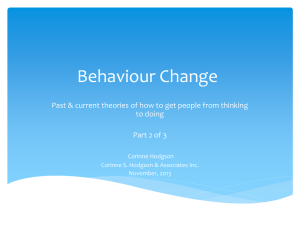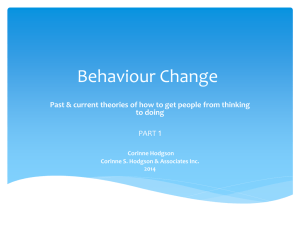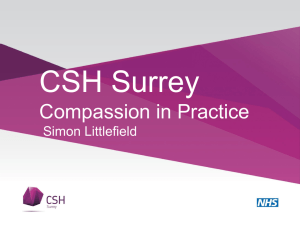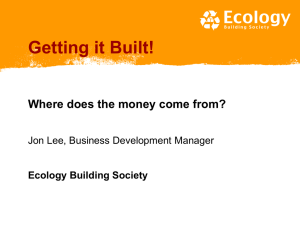BehaviourChangePresentation_CHodgson_Part3
advertisement
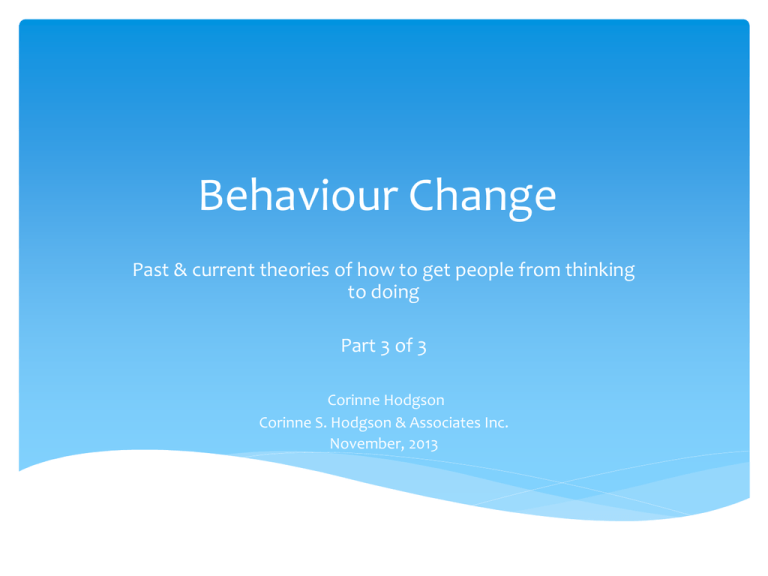
Behaviour Change Past & current theories of how to get people from thinking to doing Part 3 of 3 Corinne Hodgson Corinne S. Hodgson & Associates Inc. November, 2013 Overview Part 1 Traditional theories such as Transtheoretical Model, Model of Reasoned Action/Planned Behaviour, and Social Cognitive Theory Opportunities from other areas of psychology: achievement theory, self theory, and self-determination theory Part 2: Health Action Process Approach and SelfRegulation Part 3: New models from interactive health (Fogg, Eyal) CSH Associates - From thinking to doing 2 Fogg Behavioural Model B = mat To get a specific Behaviour you need at the same time Sufficient level of Motivation + Sufficient level of Ability + Trigger Source: http://www.behaviormodel.org CSH Associates - From thinking to doing 3 B= MAT High Motivation Activation Threshold MOTIVATION Low Motivation Triggers aren’t effective Hard to Do CSH Associates - From thinking to doing Triggers ARE effective ABILITY 4 BJ Fogg www.behaviormodel.org Easy to Do Motivation in Fogg Behavior Model Three basic motivators: Sensation – pleasure vs. pain Anticipation – hope vs. fear Social cohesion – social rejection vs. acceptance Notice: Motivators can be either approach goal (e.g., pleasure) or avoidance goal (in this case, pain) Social cohesion motivator reflects relatedness in SelfDetermination Theory How strong is the sense of motivation? CSH Associates - From thinking to doing 5 Ability in the Fogg Behavior Model Do you have the skills to change? Do you have the resources to change? Time Money Knowledge or skills Physical or mental resources (think self-regulation!) Are you asking the person to do something that is easy or hard? “Simplicity is a function of your scarcest resource at that moment.” CSH Associates - From thinking to doing 6 Triggers in the Fogg Behavior Model Behaviours will not happen without a trigger Triggers can be: External (e.g., ping on your phone) Environmental (e.g., walking into cafeteria triggers urge to eat) Internal In Fogg model there are 3 types of triggers: Facilitator: in situations of high motivation but low ability Spark: situations of high ability but low motivation Signal: situation of both high ability & motivation CSH Associates - From thinking to doing 7 Fogg Behavior Grid 15 ways behaviour can change Cross-tabulation of 2 dimensions 1. 2. The time frame One-time Limited duration Permanent change The type of behaviour change A new, unfamiliar behaviour A familiar behaviour Increasing behaviour intensity or duration Decreasing behaviour intensity or duration Stopping a behaviour CSH Associates - From thinking to doing 8 Fogg Behavior Grid/Behavior Wizard For more information go to http://captology.stanford.edu/projects/behavior-wizard-2.html CSH Associates - From thinking to doing 9 Behavior Wizard For each path, should match target behaviour with solutions Examples: For Green Dot Behaviour (to do a new behaviour one time), you need to couple the trigger with a motivational element, increase ability by explaining the novel behaviour in terms of one that is familiar, and increase motivation by highlighting benefits For Black Path behaviour (e.g., quitting smoking forever), you need to remove the trigger, reduce the motivation to smoke, and reduce the ability to smoke. For more information, go to http://www.behaviorwizard.org/wp/ CSH Associates - From thinking to doing 10 Hooked (Nir Eyal) Basic interest is in creating habit-forming apps and products but has ramifications for behaviour change – especially when using digital resources Habits are created when there are 4 elements: 1. Trigger 2. Action 3. Variable reward 4. Investment CSH Associates - From thinking to doing 11 Hooked Model TRIGGER ACTION REWARD INVESTMENT Hooked, How to Build Habit-Forming Products, Nir Eyal with Ryan Hoover CSH Associates - From thinking to doing 12 Trigger in Hooked Model External triggers: Paid triggers such as ads Earned triggers such as viral videos or news stories Relationship triggers - recommendation from a friend Owned trigger – e.g., icon on display or phone Internal triggers: Emotions such as boredom, loneliness, frustration or confusion Desire to be entertained CSH Associates - From thinking to doing 13 Action in Hooked Model Whether or not person takes action depends upon several factors Uses Self-Determination Theory (see Part 2) and Fogg Behavior Model to explain shift from inaction to action Simplicity can help movement into action CSH Associates - From thinking to doing 14 Reward in Hooked Model Not referring to incentives or virtual rewards such as virtual badges Best reward is anticipation of satisfying a need Three types of rewards: Rewards of the tribe (think relatedness) Rewards of the hunt - the most effective rewards may be variable so you never know when you’ll be rewarded Rewards of the self – Self-Determination Theory’s autonomy and competence CSH Associates - From thinking to doing 15 Investment in the Hooked Model More time and effort a person puts into an activity, product or service, they more he/she will value it The more effort and time a person puts into something, the more likely they are to consistently do it/use it The greater the investment, the greater the likelihood of responding to the next trigger CSH Associates - From thinking to doing 16 Curiosities of science - 1 Don’t ask people how they are doing in making changes (progress reports) Why not: Focuses on performance rather than effort (entity rather than growth mindset) Reminding people of how good they’ve been gives them “license to sin” Alternative: ask people to reiterate why they want to change (reinforce expectancies & motivation) CSH Associates - From thinking to doing 17 Curiosities of science - 2 Both good & bad behaviours are contagious in social networks (e.g., spread of obesity – see Christakis & Fowler NEJM 2007 video; Gladstone’s The Tipping Point) Don’t reinforce negative behaviours by suggesting they are the norm (e.g., “ over 60% of Canadians are overweight”) Alternatives: position target behaviour as the norm remind people of their goals to strengthen their immune response to others’ behaviours CSH Associates - From thinking to doing 18 Curiosities of science - 3 Don’t tell people to avoid thinking about a negative behaviour (e.g., high fat foods) Why: The more you try not to think of something: the more you will think about it & the more compelling the idea will be (ironic rebound) the more likely you are to do the very behaviour you’re trying to suppress (e.g., food restrainers are more likely to overeat) Alternative (acceptance therapy): don’t try to suppress thought but recognize it for what it is, remind yourself you don’t have to act on it, & use breathing and positive imagery to control your physiological reaction to it Lavel University study found Health-At-Any-Size approach emphasizing what people can eat & do led to better long-term weight attitudes & management than standard dieting approaches (Gagnon-Girouard J Obesity 2010) CSH Associates - From thinking to doing 19 Texts Bandura A. Self-Efficacy in Changing Societies. Cambridge University Press (1995) Decci EL, Ryan RM (eds). Handbook of Self-Determination Research. University of Rochester Press (2002) Elliot AJ, Dweck CS (eds). Handbook of Competence and Motivation. Guildford Press (2005) Glanz K, Rimer BK, Lewis FM (eds). Health and Behavior and Health Education, Theory, Research, and Practice (3rd ed). Jossey-Bass (2002) Haggar MS, NLD Chatzisarantis (eds). Intrinsic Motivation and Self-Determination in Exercise and Sport. Human Kinetics (2007) Heckhausen J, Dweck CS (eds). Motivation and Self-Regulation Across the Life Span. Cambridge University Press (1998) Sansone C, Harackiewicz JM (eds). Intrinsic and Extrinsic Motivation, The Search for Optimal Motivation and Performance. Academic Press (2000) Sheldon KM, Williams G, Joiner T. Self-Determination Theory in the Clinic, Motivating Physical and Mental Health. Yale University Press (2003) Stroebe W. Dieting, Overweight and Obesity, Self-Regulation in a Food-Rich Environment. American Psychological Association (2008) CSH Associates - From thinking to doing 20 Other Key Resources Dan Bailis research: PDF of Powerpoint http://sirc.ca/online_resources/2010SCRI/documents/Bailis_slides.pdf YouTube of presentation http://www.youtube.com/watch?v=iVLEbOXLL8k Baumeister RF, Gaillot M, DeWall CN, Oaten M. Self-regulation and personality: how interventions increase regulatory success, and how depletion moderates the effects of traits on behavior. J of Personality 2006;74:1773-1802 Sniehotta FF, Scholz U, Schwarzer R. Bridging the intention-behaviour gap: Planning, self-efficacy, and action control in the adoption and maintenance of physical exercise. Psychology & Health 2005;20:143-60 Hofmann W, Baumeister RF, Forster G, Vohs KD. Everyday temptations: an experience sampling study of desire, conflict, and self-control. J of Personality & Social Psychology 2012;102:1318-1335 Boudreax MJ, Ozer DJ. Goal conflict, goal striving, and psychological well-being. Motivation and Emotion. 2013;37:433-443 Webb TL, Joseph J, Yardley L, Michie S. Using the internet to promote health behavior change: a systematic review and meta-analysis of the impact of theoretical basis, use of behavior change techniques, and mode of delivery on efficacy. JMIR 2010;12(1):e4 Michie S, Prestwich A. Are interventions theory-based? Development of a theory coding scheme. Health Psychology 2010;29:1-8 21 CSH Associates - From thinking to doing Corinne Hodgson Corinne S. Hodgson & Associates Inc. corinne@cshassociates.com CSH Associates - From thinking to doing 22

